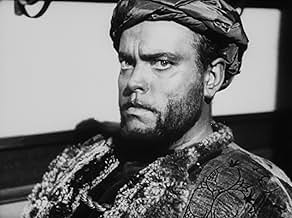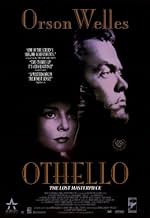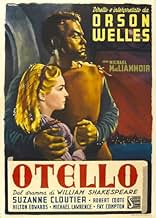NOTE IMDb
7,5/10
10 k
MA NOTE
Le général maure Othello est manipulé et pense que sa nouvelle épouse Desdémone a eu une liaison avec son lieutenant Michael Cassio alors qu'en réalité, tout cela fait partie du plan de Iago... Tout lireLe général maure Othello est manipulé et pense que sa nouvelle épouse Desdémone a eu une liaison avec son lieutenant Michael Cassio alors qu'en réalité, tout cela fait partie du plan de Iago.Le général maure Othello est manipulé et pense que sa nouvelle épouse Desdémone a eu une liaison avec son lieutenant Michael Cassio alors qu'en réalité, tout cela fait partie du plan de Iago.
- Réalisation
- Scénario
- Casting principal
- Récompenses
- 1 victoire et 1 nomination au total
Abdullah Ben Mohamet
- Pageboy
- (non crédité)
Joseph Cotten
- Senator
- (non crédité)
Jean Davis
- Montano
- (non crédité)
Joan Fontaine
- Page
- (non crédité)
Robert Rietty
- Lodovico
- (voix)
- (non crédité)
Gudrun Ure
- Desdemona
- (voix)
- (non crédité)
Avis à la une
I've always been an admirer of Welles movies, starting with citizen Kane and the other masterpieces. Considering Othello, I highly admired this movie since the first shot, when the face of the dead Othello appears suddenly in the dark, and then the other details begin to appear, revealing the awesome funeral of both Othello and his murdered wife. In fact the best thing about this movie is the synchronization of the camera movement and angles with the state of mind and moods of characters especially that of Othello. Sometimes we are actually looking at the world through Othello's mind, the images are bizarre and grotesque, this is accompanies by wonderful acting of the cast. For any Welles fan this is a must see, considering the beauty of picture and creativity of interpretation. It's a pity that Welles didn't have a sufficient financial support to surpass some technical problems although the final effect and meaning of this masterpiece is not affected at all!
I must be one of the few who saw this film (more than once!) before it vanished in the 60's. I saw it on TV in the last 50's, and later brought it to the small college where I was teaching 63-65. Though heavily cut and more than a little rearranged, it is one of the very finest of Shakespeare films. Performances are generally excellent and unified in style and diction. Welles, or course, is magnificent. Anyone who thinks he was never anything but a self-parodying ham has not seen this film. One could wish than MacLiammoir had had more overt FUN as Iago, who does what he does, in part at least, in an attempt to stimulate himself out of his blunted affect. The film also has some of the finest black-and-white cinematography of all time, and uses architecture in a unique and effective way.
Orson Welles' short, low-budget, and in places fairly odd look at Shakespeare's play. It suffers from some stage-bound performances which don't quite work (Micheal MacLiammoir as Iago, Robert Coote as Rodrigo) plus an undefined Desdemona from Suzanne Cloutier.
However, this aside, Welles is marvellous as the Moor driven to jealousy and murder, his voice rolling through the meat of Othello's speeches, his bronze make-up creating a skin for the great general. For this performance alone the film is valuable. And it looks absolutely fantastic, springing off from its financial limitations and adding a new dimension to the often-told story.
However, this aside, Welles is marvellous as the Moor driven to jealousy and murder, his voice rolling through the meat of Othello's speeches, his bronze make-up creating a skin for the great general. For this performance alone the film is valuable. And it looks absolutely fantastic, springing off from its financial limitations and adding a new dimension to the often-told story.
10EddieK
Considerable controversy has surrounded the 1992 restoration and re-release of Orson Welles' "Othello." First, the film was wrongly labelled a "lost classic" - not technically true, as Welles aficionados will realize. More seriously, the restoration crew (under the aegis of Welles' daughter, Beatrice Welles) re-synced the dialogue and re-recorded the musical score - an abomination to Welles purists. While it would have been preferable to adhere to Welles' vision for the film, such an endeavor becomes extremely difficult when no written record of Welles' intent exists (as it did with his famous 26-page memo to Universal regarding "Touch of Evil"). So it's true that the restored version lacks a degree of authenticity, but what are the alternatives? Grainy, scratched, poorly synced public domain prints (c.f. "Mr Arkadin" and "The Trial")? Or, worse, no available copy at all (c.f. "Chimes at Midnight")?
Anyway, on to the film. "Othello's" existence helps disprove the charges of profligacy and "fear of completion" that plagued Welles' career after "Citizen Kane." Shot over four years in Morocco and Italy, and financed largely by Welles himself, "Othello" manages to avoid a low-budget look, thanks largely to virtuoso editing that masks the incongruities of time and space. Welles' powers of invention are on full display here, most obviously in the famous Turkish bath scene (an improvised set necessitated by a lack of costumes). Set designer Alexandre Trauner's astute choice of Moroccan and Venetian locations instantly establishes a geographic authenticity; Welles initially exploits them for all their stark beauty before retreating into noirish interiors, underscoring Othello's descent into darkness.
Aside from Michael Macliammoir's chilling Method performance as Iago, the acting in Welles' "Othello" has been criticized as too restrained and modulated for Shakespearean tragedy. Such criticism is largely unwarranted, for this "Othello" is as much for the eyes as the ears: Welles' bold framing and expressionistic camera angles free the play from its theatrical moorings (pun intended), undermining the need for stage elocution. Indeed, the camera is the true star of this film, as Welles generates images that match the grandeur and eloquence of Shakespeare's language.
Anyway, on to the film. "Othello's" existence helps disprove the charges of profligacy and "fear of completion" that plagued Welles' career after "Citizen Kane." Shot over four years in Morocco and Italy, and financed largely by Welles himself, "Othello" manages to avoid a low-budget look, thanks largely to virtuoso editing that masks the incongruities of time and space. Welles' powers of invention are on full display here, most obviously in the famous Turkish bath scene (an improvised set necessitated by a lack of costumes). Set designer Alexandre Trauner's astute choice of Moroccan and Venetian locations instantly establishes a geographic authenticity; Welles initially exploits them for all their stark beauty before retreating into noirish interiors, underscoring Othello's descent into darkness.
Aside from Michael Macliammoir's chilling Method performance as Iago, the acting in Welles' "Othello" has been criticized as too restrained and modulated for Shakespearean tragedy. Such criticism is largely unwarranted, for this "Othello" is as much for the eyes as the ears: Welles' bold framing and expressionistic camera angles free the play from its theatrical moorings (pun intended), undermining the need for stage elocution. Indeed, the camera is the true star of this film, as Welles generates images that match the grandeur and eloquence of Shakespeare's language.
I will not go into the film as many already have said how it is a great work of art despite its "troubled" filming history.
This film is now advertised and available as a "restored" dvd of a "lost" Welles film. But DO NOT be deceived. Whereas the 1998 cut of Touch of Evil was "restored" using a Welles memo as guidelines, Othello was restored by presuming many things. First, dialogue was put in sync and unintelligible diaglogue was "voiced over." And second, the original score was redone, but not exactly as the original. You could almost say a new score was used in the "restored" film. The original cut was Welles' 1952 European version which has only ever been availible as a (OOP) 1995 Criterion LaserDisc. As Welles' daughter owns the rights to Othello, that's the 1992 "restored" version which she also helped on, it is the only one currently availible for purchase in the US (as she receives no money for the 1995 CR laserdisc, she forced Criterion to stop making it.)
While many casual fans will not notice or care about the little changes, don't be deceived into thinking this is "Orson's intended version." Also DO NOT be deceived into thinking this is a lost film. It was only lost in the sense that it had no distribution until the early 90's.
This film is now advertised and available as a "restored" dvd of a "lost" Welles film. But DO NOT be deceived. Whereas the 1998 cut of Touch of Evil was "restored" using a Welles memo as guidelines, Othello was restored by presuming many things. First, dialogue was put in sync and unintelligible diaglogue was "voiced over." And second, the original score was redone, but not exactly as the original. You could almost say a new score was used in the "restored" film. The original cut was Welles' 1952 European version which has only ever been availible as a (OOP) 1995 Criterion LaserDisc. As Welles' daughter owns the rights to Othello, that's the 1992 "restored" version which she also helped on, it is the only one currently availible for purchase in the US (as she receives no money for the 1995 CR laserdisc, she forced Criterion to stop making it.)
While many casual fans will not notice or care about the little changes, don't be deceived into thinking this is "Orson's intended version." Also DO NOT be deceived into thinking this is a lost film. It was only lost in the sense that it had no distribution until the early 90's.
Le saviez-vous
- AnecdotesWhen he made La rose noire (1950), Orson Welles insisted that the coat his character wore be lined with mink, even though the lining would never be visible in the finished film. The producers acquiesced to this demand. When the shoot was over, the coat disappeared. In "Othello", Orson Welles can be seen wearing the same coat, complete with mink lining.
- Versions alternativesThis film by Orson Welles, was 'restored' by a group in Chicago in 1991/2. The film was transferred to, and enhanced in video, (D1 format) retaining it as black and white. The audio was completely rebuilt, including the score, in Stereo Surround. All dialogue, however was original. This was a problem as some of the dialogue was distorted and unintelligible. John Fogelson, editor, was a major supervisor of the project. Ed Golya, Lorita DeLacerna, and Steve Wilke, were digital editors. And Ed Golya remixed the soundtrack. The process took 9 months. It was purchased for distribution by Castle Hill, and taken to New York where it went through another transformation before release. The restoration engineer in New York, Paul Michael, restored the audio that was supplied on 35mm optical negatives. He was able to remove the distortion, optical pops and surface noise that is inherent with Optical negatives. The restored audio was then sent to Sound One for the final mix. Unintelligible dialogue was replaced with 'sound-alikes'. This decision was made for the entertainment value of the film. The original mono music was then reintroduced into the final product. Basically, the film was retransferred, and the rebuilt sound effects tracks were added. This was done at Sound One, in NYC.. The credits were adjusted to place Lee Dickter (sp?) as Re-recording Mixer, and Ed Golya as Sound Effects Editor.
- ConnexionsEdited into Histoire(s) du cinéma: La monnaie de l'absolu (1999)
Meilleurs choix
Connectez-vous pour évaluer et suivre la liste de favoris afin de recevoir des recommandations personnalisées
- How long is Othello?Alimenté par Alexa
Détails
- Date de sortie
- Pays d’origine
- Sites officiels
- Langues
- Aussi connu sous le nom de
- Orson Welles' Othello
- Lieux de tournage
- Castle, El Jadida, Maroc(cistern interior)
- Sociétés de production
- Voir plus de crédits d'entreprise sur IMDbPro
Box-office
- Montant brut aux États-Unis et au Canada
- 28 980 $US
- Week-end de sortie aux États-Unis et au Canada
- 6 010 $US
- 27 avr. 2014
- Montant brut mondial
- 28 980 $US
- Durée
- 1h 30min(90 min)
- Couleur
- Rapport de forme
- 1.37 : 1
Contribuer à cette page
Suggérer une modification ou ajouter du contenu manquant


































